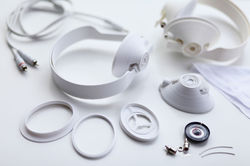top of page
UI/UX DESIGN PROCESS
 1. Research and DiscoveryObjective: Understand the target audience, their needs, and the problem the product aims to solve. User Research: Conduct surveys, interviews, and usability testing to gather insights. Competitive Analysis: Analyze similar products to identify strengths, weaknesses, and gaps. Stakeholder Interviews: Understand business goals and technical constraints. |  2. Defining RequirementsObjective: Translate research insights into actionable goals and project scope. Personas: Fictional characters representing target users and their behaviors. User Journeys: Mapping out steps a user might take to achieve their goals. Problem Statements: Define the key issues to address. Requirements Documentation: List features and functionalities needed. |  3. Ideation and ConceptualizationObjective: Generate and refine ideas for the design solution. Brainstorming: Team sessions to explore various design directions. Sketching: Quick hand-drawn ideas for layouts and interactions. Wireframes: Low-fidelity blueprints focusing on structure and hierarchy without detailed visuals. |
|---|---|---|
 6. Testing and ValidationObjective: Ensure the design meets user needs and expectations. Usability Testing: Observe users interacting with prototypes to identify pain points. A/B Testing: Compare different design versions to see which performs better. Feedback Collection: Use surveys and analytics to gather user insights. |  4. PrototypingObjective: Create interactive representations of the product. Low-Fidelity Prototypes: Basic clickable wireframes to test functionality. High-Fidelity Prototypes: Detailed and interactive designs that closely resemble the final product. |  5. Visual DesignObjective: Define the product's look and feel. Style Guides: Create consistent rules for colors, typography, and UI components. Mockups: Detailed visual representations of the product. Brand Integration: Ensure designs align with the company’s brand identity. |
INDUSTRIAL DESIGN PROCESS
 1. Research and DiscoveryUnderstand the problem: Define the design challenge or opportunity. User research: Conduct interviews, surveys, and observations to understand user needs and behaviors. Market analysis: Identify trends, competitors, and target audience. Technical constraints: Understand materials, manufacturing processes, and regulatory requirements. |  2. Ideation and Concept DevelopmentBrainstorming: Generate a wide range of ideas and concepts. Sketching: Create quick hand-drawn or digital sketches to visualize ideas. Mood boards: Compile visual references to establish the aesthetic direction. Concept selection: Evaluate ideas based on functionality, aesthetics, and feasibility. |  3. Prototyping and IterationRapid prototyping: Create mock-ups using materials like foam, paper, or 3D printing. User testing: Gather feedback on prototypes to refine functionality and design. Iterate: Incorporate feedback into updated prototypes. |
|---|---|---|
 6. Manufacturing PreparationProduction-ready CAD: Finalize models for manufacturing. Tooling design: Create molds or tools for production. Supply chain coordination: Source materials and manufacturers. |  4. Detailed DesignCAD modeling: Develop detailed 3D models using computer-aided design software. Material selection: Choose materials based on durability, aesthetics, and cost. Engineering collaboration: Work with engineers to ensure manufacturability and performance. |  5. Validation and TestingObjective: Create interactive representations of the product. Low-Fidelity Prototypes: Basic clickable wireframes to test functionality. High-Fidelity Prototypes: Detailed and interactive designs that closely resemble the final product. |
bottom of page
